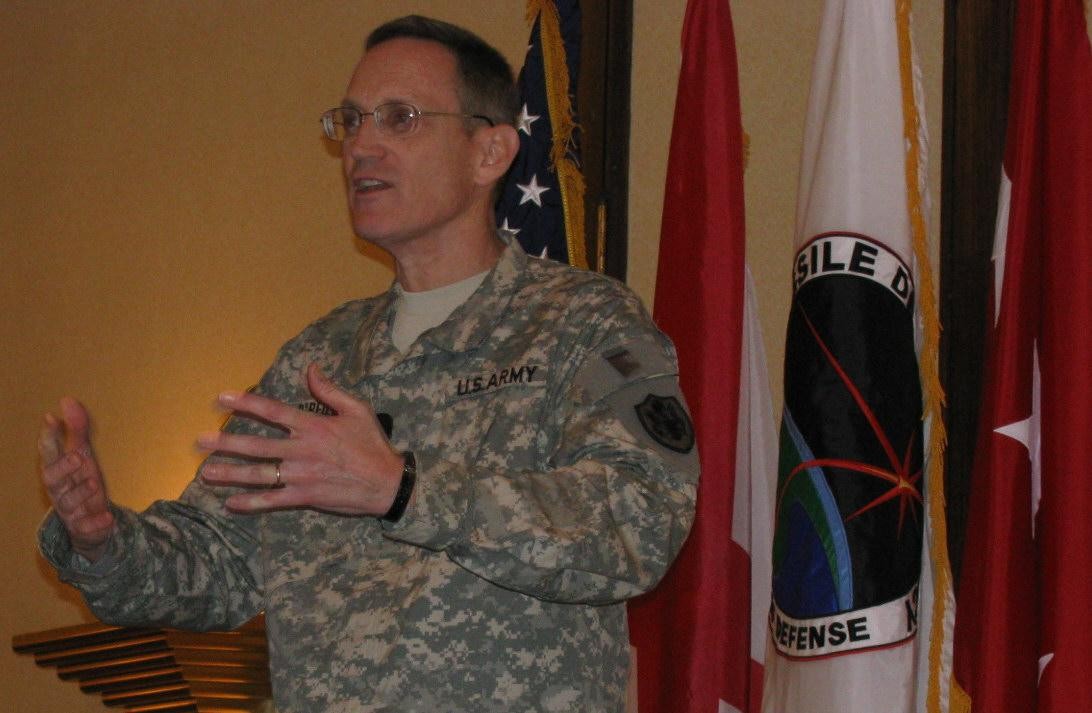
The growing threat of ballistic missile proliferation around the world is a concern not only of military leaders but also of President Obama's administration, said the new director of the Missile Defense Agency.
Speaking to a gathering of more than 400 local military and industry leaders at Friday's luncheon meeting of Women in Defense at the Huntsville Marriott, MDA director Lt. Gen. Patrick O'Reilly said China and Russia are not the only nations who have the capability to be a significant ballistic missile threat.
"If you remove China and Russia from the picture, there are still 1,100 more missiles today and in the next five years there will be 1,500 more missiles than there are today. That brings to 7,000 the number of ballistic missiles" and over 1,000 ballistic missile launchers owned by nations throughout the world, he said.
More than 20 foreign countries have ballistic missile systems. Instead of testing their systems once a month or once a week, they are testing them daily.
"The question is how many launches do they do every day," O'Reilly said. "Proliferation is growing. The new administration knows this. It's a serious question of how to stop missile proliferation."
The growing number of countries with ballistic missile capability creates unpredictability in the international military and political environment. Nations, particularly poor nations, are spending more and more money on ballistic missiles, causing U.S. political and military leaders to be concerned about the motives behind such investment.
"The threat over and over again is very uncertain," he said. "There is a huge uncertainly out there. But one thing is confirmed and that is proliferation."
The Women in Defense luncheon is the largest Huntsville group that O'Reilly has spoken to since taking over at MDA in November. He oversees MDA's worldwide mission to develop a capability to defend deployed forces, and the U.S. and its allies and friends against ballistic missiles.
When speaking to various groups about missile defense, O'Reilly said he has learned that he should include an introduction to the fundamentals of ballistic missiles so that his audiences understand his message.
Briefly reviewing such systems as Aegis, THAAD (Terminal High Altitude Area Defense), the Ground-Based Midcourse Defense Program, Patriot, the Navy's SM3s and others, O'Reilly told his audience "each of the systems we are developing have a unique capability. All have a unique performance function in our architecture. Each one of these systems is designed to go against a specific threat and they are not interchangeable ... The key here is that since each system is designated against a major threat we need to get them to work together."
Together, these systems create the missile defense net to protect deployed forces, the U.S. and its allies against a ballistic missile threat from another country.
"We are starting to intertwine the net and see how effectively it works," O'Reilly said of testing that is being done with multiple systems.
"We are exercising different parts of this network" and involving ballistic missile systems established in places like Greenland, Hawaii, Israel, Japan and Arkansas. In addition, the systems will eventually be enhanced with the European Midcourse Radar system that will increase the missile defense net area in Europe.
O'Reilly said testing is beneficial, even when there are failures such as in the 1990s and early 2000s. These failures show engineers where improvements must be made. There has been tremendous success in recent testing, with THAAD succeeding in all five of its simulated intercepts, Aegis succeeding in seven out of eight and the Ground Based Midcourse Defense system succeeding in all three of its tests.
"We are going to have failure and we are going to learn from it ... I have confidence in the system doing the scenario we've tested it on. But none of the systems are done with testing. There will be testing done for years to make sure systems are operationally effective, suitable and survivalable" as MDA develops a comprehensive flight test and ground test program, he said.
O'Reilly said upcoming testing will be aggressive so that "we prove this system's significant capability."
He also said that anytime the U.S. conducts a successful test, the reaction can be viewed on a worldwide scope. A successful missile defense system for the U.S. and its allies devalues missile development being done in countries that may be perceived as a threat, provides allies with options in addition to a pre-emptive strike, stabilizes events in a crisis and assures protection of population systems and critical assets.
The general took a few minutes during his speech to give a "sales pitch" to his audience about the need for young engineers to seek out positions with MDA and other military organizations. He said the average age of the engineering work force is 46, and that MDA is working on recruiting and mentoring programs to encourage young engineers to enter the work force.
O'Reilly also mentioned that MDA was doing well on BRAC recruiting plans in North Alabama. But the recent downturn in the economy and especially in regard to the housing market has made it more difficult to convince civilian engineers to move to the Huntsville area with MDA.

Social Sharing